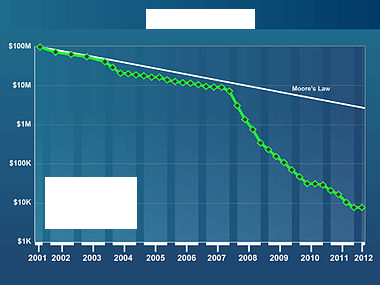Here’s a well-known graph:

I’ve taken it from Wikipedia where it is CC-BY [1] and hacked the captions out, Try to guess what it is before clicking this link.
Moore’s law is an observation that technology drives cost reduction in computing, information, etc. by about 0.5 every 18 months. Here’s an information-rich domain which reduces costs even faster. It’s a combination of:
- People want it
- The people doing it are innovators
- They understand the dynamics of the C21
- The basic information is Open.
- There is a synergy between the people and organizations that provide the totality of the product
- Government and industry work together for mutual benefit.
If you plot the cost of #scholpub it would be effectively level.
So why doesn’t Moore’s law apply to #scholpub?
Answer from conventional publishers: “our business is special. We add so much value year-on-year and so much volume the cost has to go up”.
Answer from PMR: Moore’s Law DOES apply. And the cost is now at a discontinuity. Say a factor of TEN. Yes, #scholpub does not costs thousands of dollars. It’s information. It’s cheap. A paper in Elsevier hybrid is the same price as a small car!
And the longer it goes on the greater the publisher-crash will be.
[1] (I can’t take a similar image from SpringerImages as that would violate copyright #springergate)
Pingback: Around the Web: Potternomics, PeterSuberNomics, #ScholPubNomics and more – Confessions of a Science Librarian
Pingback: What really drives Moore’s Law « cartesian product